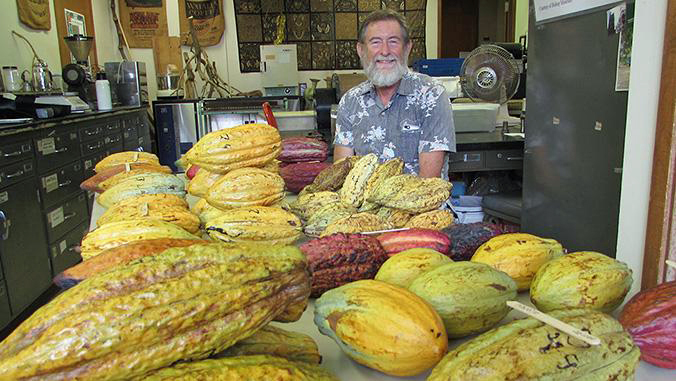
Beans from a University of Hawaiʻi cacao trial begun in 2005 were among the 18 International Cocoa Awards winners announced at the Salon du Chocolat in Paris in November. The cacao from three locations in the College of Tropical Agriculture and Human Resources (CTAHR) field trial were selected as best in the Asia, Pacific and Australia category, along with an entry from Jeanne Bennet and Bruce Clements’ Nine Fine Mynahs Estates in Waialua and samples from Australian, India and Malaysia.
“This recognition proves what we already know—Hawaiʻi grown cacao produces a high quality chocolate with a superior flavor profile,” said CTAHR Extension Specialist H.C. “Skip” Bittenbender, who established the Hawaiʻi State Cacao Trial with the help of then graduate student Daniel O‘Doherty.
The Cocoa of Excellence Programme is held every two years by Bioversity International to recognize flavor and diversity of cocoa according to its origin. The 13 other cocoa beans of note were from South America, Africa/Indian Ocean and Central America/Caribbean regions.
This recognition proves what we already know—Hawaiʻi grown cacao produces a high quality chocolate with a superior flavor profile.
—H.C. “Skip” Bittenbender
Bittenbender is a cacao, coffee and kava specialist in the Department of Tropical Plants and Soil Sciences. He tended the entered cacao at CTAHR’s Urban Garden Center in Pearl City and Waimānalo Experiment Station and at Kualoa Ranch makai. O‘Doherty, who now works as an international cacao consultant, fermented and dried the beans.
At the competition, beans that passed a physical quality evaluation were processed into liquor and untempered chocolate for blind sensory evaluation by a panel of international experts. The top 50 were processed into tempered and molded chocolate (following the same recipe of 66 percent cocoa) for sensory evaluation by a broader panel of 41 chocolate professionals.

A new niche crop
Competition organizers lauded the flavor and diversity of cacao at the 2017 event. The genetic origin of UH’s competition cacao is primarily upper Amazon. The flavor profile posted by evaluators suggests a distinct and naturally acidic fruitiness followed by a raisiny component balanced by roasted cocoa with moderate bitterness and astringency.
“With no major cacao diseases in Hawaiʻi, we are in a unique position to grow many rare and fragile cacao varietals, and the pollinator is an endemic insect” O‘Doherty said. The UH cacao trials include eight selections grown from pods produced in Hawaiʻi plus two international varieties, all grafted onto seedling rootstock from Mānoa Valley and grown at six sites around O‘ahu.
“By identifying high-yield, high-quality cacao varieties and testing growing methods, CTAHR is helping local producers develop a new niche crop for the islands,” added Bittenbender. He anticipates the release soon of variety UH3, to be named ‘Easton’ in honor of former CTAHR tree crops extension agent Virginia Easton Smith.
Bittenbender and O‘Doherty have worked closely with Kauaʻi producer William Lydgate of Steelgrass Farm, who also made the initial shortlist of 50 samples from 40 countries, and they collaborated on the cacao chapter for the book Specialty Crops for Pacific Islands published by the University of Hawaiʻi Press.
Bittenbender has also written on small farm cultural practices, harvesting, fermenting and drying of cacao. His latest publication, in October’s HortTechnnology, describes The CTAHRBag system for microfermentation of cacao, developed with CTAHR agricultural engineer Loren Gautz, Tropical Plants and Soil Sciences graduate student Jason Myers and mainland-based cacao flavor expert Ed Seguine. Clean, inexpensive, disposable polyethylene bags serve as fermentation vessels and humidity-controlled laboratory drying replaces sun drying to create a flexible and reliable method appropriate for small-scale producers and hobbyists as well as scientists evaluating new varieties for quality and yield.


